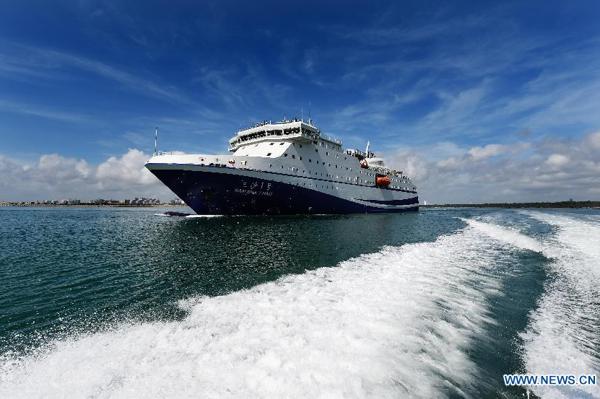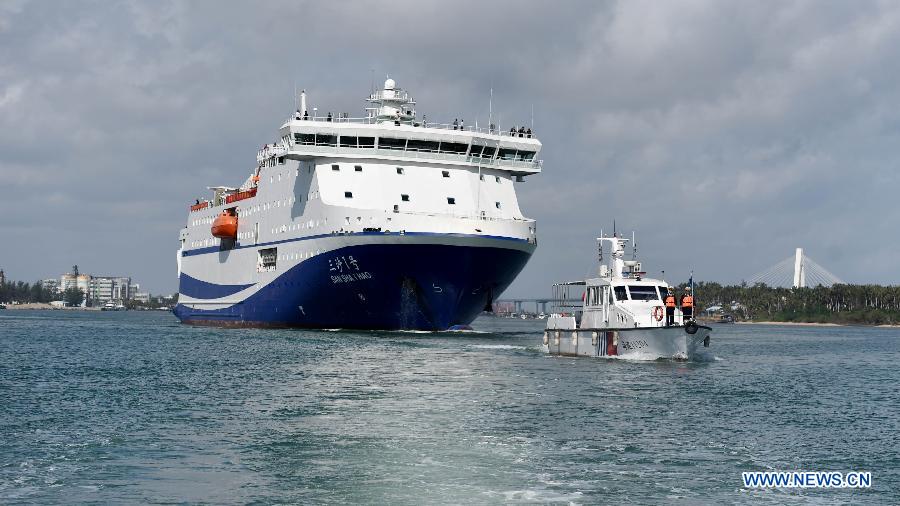
The Sansha I leaves for Sansha from Wenchang, south China’s Hainan province, Jan 5, 2015. The new ship set sail on Jan 5 from Hainan Island for Sansha city on its maiden voyage to supply islands in the vast South China Sea. The civil ship Sansha I is the largest and most advanced vessel yet to supply and commute between Hainan Island and islets in the South China Sea.[Photo/Xinhua]
HAIKOU — A new ship set sail on Jan 5 from Hainan Island for Sansha city on its maiden voyage to supply islands in the vast South China Sea.
The civil ship Sansha I is the largest and most advanced vessel yet to supply and commute between Hainan Island and islets in the South China Sea.
At an inaugural ceremony held at the ship’s home port in Wenchang city, Sansha Mayor Xiao Jie said the new vessel will expand the city’s administration in the South China Sea and underpin China’s efforts to defend its “blue territory” and safeguard its interests in the sea.
“The all-weather Sansha I can cover all waters in the South China Sea and will reach more islets and reefs in the remote Zhongsha and Nansha island groups,” said Feng Wenhai, vice-mayor of Sansha.

The Sansha I anchors at harbor in Wenchang, south China’s Hainan province, Jan 5, 2015. [Photo/Xinhua]
Sansha I, 122 meters long and 21 meters wide, has a displacement of 7,800 tons. The rollon-rolloff vessel can accommodate up to 456 people and carry 20 standard container trailers.
The ship can navigate 6,000 nautical miles without docking and sail at a speed of up to 19 nautical miles per hour. The ship also has a helicopter pad to facilitate maritime rescue and islet patrol.
Sailing time between Wenchang city on Hainan Island and Sansha city’s seat of government at Yongxing Island will be reduced to about 10 hours from 15 hours. Sansha I will make a round trip once a week.
China’s southernmost and youngest city, Sansha was established in July 2012 to administer more than 200 islets, sandbanks and reefs in the Xisha, Zhongsha and Nansha island groups as well as two million square kilometers of surrounding waters in the South China Sea.

The Sansha I leaves for Sansha from Wenchang, south China’s Hainan province, Jan 5, 2015.[Photo/Xinhua]
The Chinese Ministry of Land and Resources said the South China Sea’s oil reserves are estimated to be around 23 to 30 billion tons, with gas reserves believed to total about 20 trillion cubic meters.
Data from the Hainan Provincial Fisheries Research Institute showed that the potential catch in waters administered by Sansha City adds up to five million tons.
Since it was established, Sansha has been building large-scale infrastructure on its islets and reefs. The number of residents, workers and visitors is increasing.
However, Sansha city relies heavily on supplies shipped from Hainan Island and the mainland, more than 300 kilometers away.
Ouyang Xiong, deputy director of Sansha Maritime Safety Administration, said as Sansha city develops rapidly, there is growing demand for supplies.
“Sansha I will inject fresh vigor into the city’s development,” said Xiao.

A staff member of local marine bureau guide the Sansha I to leave the port in Wenchang, south China’s Hainan province, Jan 5, 2015. [Photo/Xinhua]

A passenger of Sansha I shows her ticket in Wenchang, south China’s Hainan province, Jan 5, 2015. [Photo/Xinhua]

Staff members of local marine bureau check Sansha I at the harbor in Wenchang, south China’s Hainan province, Jan 5, 2015. [Photo/Xinhua]
